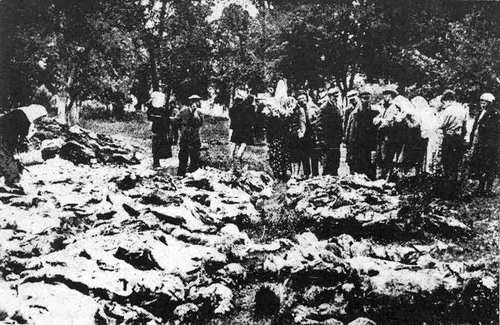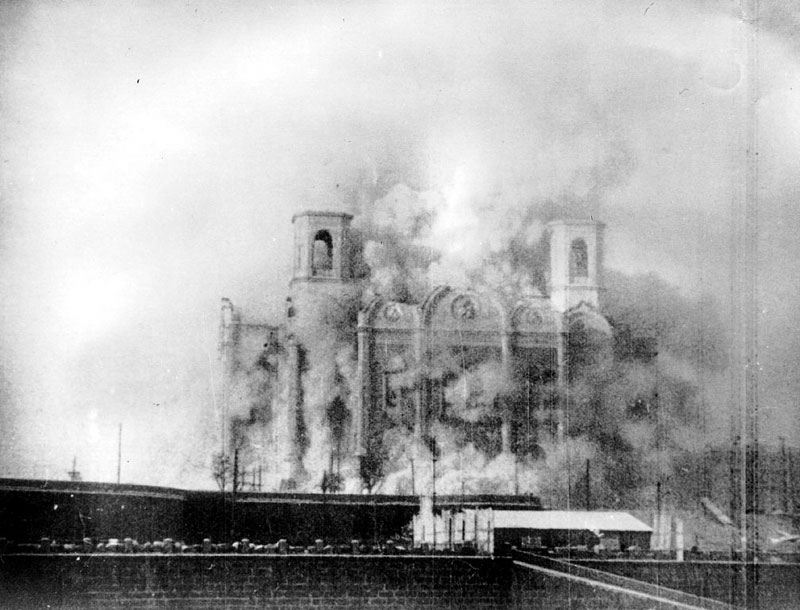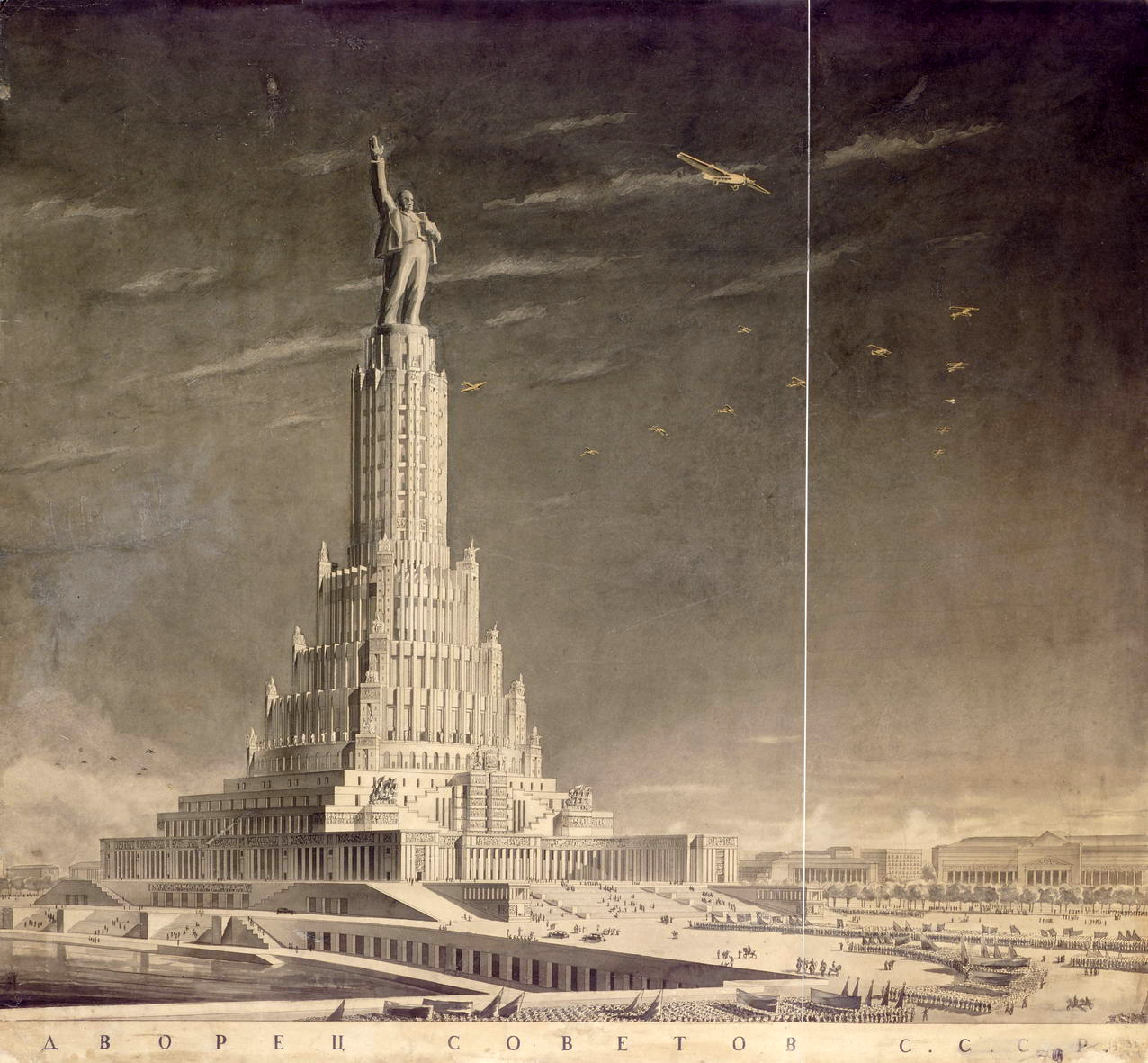

Mark 16:1-8
Hebrews 11:33-12:2
Matthew 4:25-5:12
|
"Blessed are you when men revile you and persecute you and
utter all kinds of evil against you falsely on my account." In the Name of the Father and of the Son and of the Holy Ghost. Amen. |
If you should seek a guide for reading cultural currents or signs of the times, the first figure who comes to mind is not a religious hermit. At the Hermitage we do not have a television or a radio. We do not subscribe to newspapers. We do not belong to political parties, nor are we registered to vote. As a parish priest, my parishioners would ask if I were Republican or Democrat. "Who are you for, Father?"
I would reply, "I am for you, and I am not against any member of this parish. It follows that I am not in any partisan push-and-pull."
Yes, there is the Worldwide Web, which makes possible our only ministry of ideals and values. But we do not use it to participate in the contemporary culture. I struggle, therefore, with crossword puzzles, which are steeped in contemporary news and culture. I look for clues having to do with the Bible, but these have thinned out to almost nothing in recent decades.
Puzzles do come to me through my alumnae magazines. Recently, I was stymied by a clue: "Challenging period for all college students?" What could the answer be? First class period of the day at 8 o'clock? Perhaps it was Ancient Greece with its language challenges? The answer astounded me: Modernity. The modern period was challenging for young people everywhere.
You see, I had assumed the traditional model: old people (especially religious hermits) always struggle with modernity, but young people always love it. In the late 1930s young people loved to swallow goldfish to the disgust of their grandparents. In the late 1950s young people loved to cram into phone booths and listen to rock-and-roll as their parents shook their heads. In the late 1960s young men suddenly grew their hair long and took psychedelic drugs to the universal shock of their parents and grandparents. In all of these cases, young people reveled in their "wild and crazy passions," and the older generation winced. But today we see a fundamental change, perhaps for the first time in U.S. culture. Today, the younger generation finds their own era to be a challenge and a struggle. Modernity is seen as being hazardous by young people.
Of course, crossword puzzles are not my only oracle for this astonishing insight. I do have contact with real, flesh-and-blood young people: family members, young men who work on the Hermitage Farm, random people who talk to me about their cares. And they tell me the same thing. They do not feel safe. They want to retreat ... maybe leave the U.S. and the Americanized world. (One girl mentioned Finland, where she had never visited.) And the reason for this? Why, the world has gone mad! What is astounding is that this is no longer the opinion of religious hermits (which has been the case for nearly two thousand years and attested in the Letters of St. John the Theologian, of St. Paul, and throughout the Sacred Scriptures). No. This is the opinion of young people, now, in the United States. That is, the world has become repugnant to those whose world it is!
What is it about the world that makes it so toxic? May I venture an answer? For the first time in U.S. history, we have entered a post-morality era. In our time, morality is seen as being inimical to human rights and freedoms, even to human enlightenment. The new, invented rules for human conduct are a matter of individual taste and discernment. Conversations about God are not tolerated in the public square. We can no longer agree across the board that rioting and looting are bad things, not if they can be explained with brave-sounding phrases and causes. We can no longer agree that our country and homeland should be protected, much less loved. We can no longer agree that decency should be practiced in our language or subject-matter or the images we display. Sexual modesty disappeared decades ago and across all generational boundaries — ranging from our elementary school children to grandmothers and great-grandmothers. Yes, we have lived to see a very great landmark in our historical timeline: the End of Decency.
Exactly who are the people who want this post-God world with its inevitable outcome of post-morality life? We may term them secularists. Their religion is not God-based, but rather "Nanny-state"-based. The Nanny-state should not have anything to say about our conduct of life. It should simply provide: income, housing, food, medical care, and everything else that one might need. How about family structure? Well, that does not really matter, for families might censure one's conduct. What matters are two things: freedom from moral censure and being provided for.
We should not be so shocked by these developments though no one in the U.S. saw this mad, mad world coming a half-century ago. People assumed that American life would just go on as it always had: love of family, love of God, love of country, sensible freedoms and liberties. But we should have seen it coming, for its volcanic eruptions have been the stuff of the dawn of modernism (or modernity). It is not a coincidence that the French Revolution and the Scientific Revolution happened at about the same time. Both sought to sweep away belief in God, morality, and social traditions and traditional values.
The great explosion and cataclysm of our time was the Bolshevik Revolution and the civil war that followed. A mob of secularists led by atheist leaders, Lenin, Trotsky, Molotov, Stalin et al., with breathtaking speed destroyed the God-fearing lifeworld around them and attempted to build a new lifeworld based on their secularist, Nanny-state values. They would call their new religion scientific atheism based on contemporary (and now outdated) philosophy and inchoate ideas of the revolutionary leaders. And what would be their most visible target in this path of chaos and destruction? Why, the Church of course. Two images will capture the scale and spirit of this ruinous revolution. First is the Cathedral of Christ the Saviour in Moscow and the second is the Moscow Palace of Soviets.
 The Cathedral of Christ the Saviour was constructed
"to signify Our gratitude to Divine Providence for saving Russia from the doom that overshadowed Her,"
in the words of Tsar Alexander I,
following the retreat of Napoleon.
That is,
it was a monument to signify the triumph of God over the ruinous chaos of events
begun by the French Revolution.
Construction took place over a period of more than seventy years
featuring marble plaques listing the major commanders and regiments
who had resisted Napoleon requiring 11,000 square feet.
Tsaikovsky wrote the 1812 Overture on the occasion of its consecration.
The Cathedral of Christ the Saviour was constructed
"to signify Our gratitude to Divine Providence for saving Russia from the doom that overshadowed Her,"
in the words of Tsar Alexander I,
following the retreat of Napoleon.
That is,
it was a monument to signify the triumph of God over the ruinous chaos of events
begun by the French Revolution.
Construction took place over a period of more than seventy years
featuring marble plaques listing the major commanders and regiments
who had resisted Napoleon requiring 11,000 square feet.
Tsaikovsky wrote the 1812 Overture on the occasion of its consecration.
The Bolsheviks detested this glorious paean to God and destroyed it,
one of the world's largest and most beautiful churches,
in 1931.
In its place the Soviet government decided to build a monument to Lenin
called the Moscow Palace of Soviets.
 But this outsized ambition for building a monstrosity
—
a towering building 1,624 feet high with an enormous statue of Lenin himself on top
—
was never to be built,
stumbling from government fatigue.
For as the failed Soviet Union itself demonstrated,
one cannot go very far when the inner life of a movement or a nation is no inner life,
emptiness,
only brave-sounding phrases and grotesque egotism.
But this outsized ambition for building a monstrosity
—
a towering building 1,624 feet high with an enormous statue of Lenin himself on top
—
was never to be built,
stumbling from government fatigue.
For as the failed Soviet Union itself demonstrated,
one cannot go very far when the inner life of a movement or a nation is no inner life,
emptiness,
only brave-sounding phrases and grotesque egotism.
The authentic Church, founded by God and instituted by the Apostles, will always be our only safety and safeguard against the excesses of the narcissistic human spirit. Nothing can destroy the true Church. Nothing can intimidate authentic bishops, priests, deacons, vowed religious, or the faithful. Nothing. For this is real life, not the vain imaginings of a mob looking for the next exciting thing and reveling in the destruction of the good.
The secularist government of Russia exterminated twelve to twenty million Christians. (Six million Jews died during the Holocaust .... this number is twenty million.) Yet, they could not extinguish the Russian Orthodox Church. During the two-year Great Purge alone, 106,300 clergy were murdered. Can you imagine, in twenty-four months, the murder of 106,300 bishops, priests, and deacons? Roving vigilantes would break into little churches murdering the pastor and his wife, and then defacing the sacred icons, the altar, and anything else that thrilled them.
We at the Hermitage believe, joining the Russian Othodox Church, that we have arrived to the very kernel, essence, and core of the real Church, which our Lord and Savior founded. She is authentically an instance of the One Holy Catholic and Apostolic Church. We live in the safety of being governed by truly holy men: our Patriarch Kirill of Moscow and our Primate Hilarion, First Hierarch of the Russian Orthodox Church Outside Russia (called ROCOR).
Why "Outside Russia"? Because as the dying light continued to dim in Moscow in 1922, the Church's great Patriarch, St. Tikhon, issued a decree entrusting the governance of the Church to the Russian Church Abroad (which would also be known as ROCOR). It would in this safe "amber," so to speak, that the pure Russian Orthodox Church would be preserved and protected. When the Church had recovered her integrity in Moscow, ROCOR reunited with her. And on May 17, 2007 an Act of Canonical Communion was signed in Moscow.
Why is the Russian Orthodox Church so central to all Christians of our age, in this time of madness? Because we at the Hermitage believe that she will be the last to fall to the secularist culture. She will not bow down before the culture. She will not attempt to reform herself in the image of the age. She will "update" herself to curry favor with multitude. She has been tried in fire, forged in the furnace of the most fearsome secularist movement in the history of humankind, the dark empire of the Soviet Union. A statement found on the ROCOR website, the Cathedral of the Holy Trinity in Washington (founded by St John of Shanghai and San Francisco), says it more eloquently than I ever could. Please indulge me in this three-paragraph statement. It goes to the heart of who we are and why we are Russian Orthodox:
|
Christians in the United States should be prepared to live in a cultural environment increasingly hostile to traditional morality in general, and to Christianity in particular.
To create such an environment of hostility, and ultimately to bring the Church under active persecution,
has always been the aim of our invisible enemies,
who indeed have had their role in bringing about these societal changes.
Given the steep trajectory of change in societal attitudes on this issue,
increasing persecution of the Church and discrimination against Her faithful members is likely.
In the face of such hostility and ostracism, we must respond with both truth and love. We must live up to our highest aspirations, making clear the other-worldly dimension of Christianity. Our forbears emerged into the world of late-classical antiquity with a radical, life-transforming alternative to the worldview of pagan society; increasingly, this will be our position in our secularist society. The days of "fitting in" will come to an end. Under persecution, we will either become more Christian or less; there will be no middle ground. We should not be daunted by these things, remembering the words of our Lord and Savior, In the world ye shall have tribulation: but be of good cheer; I have overcome the world (John 16:33). The Church has experienced many periods of persecution in Her history, and has only added to Her choir of saints. May we be accounted worthy of them. Amen. |